How to Keep Personally Identifiable Info Out of Google Analytics
Not too long ago, we found one thing alarming whereas auditing one among our shoppers’ web sites. E mail addresses and cellphone numbers had been exhibiting up of their Google Analytics stories, exposing delicate customer info that they by no means supposed to gather.
Amassing personally identifiable info from customers generally is a main challenge. Not solely does it violate privateness rules like GDPR, however it additionally places your online business prone to hefty fines and shedding the belief of your prospects.
However right here’s the excellent news: stopping personally identifiable info (PII) from ending up in your analytics is definitely fairly simple as soon as you understand how.
We’ve spent years working with Google Analytics throughout lots of of internet sites, and we’ve developed a foolproof system to maintain delicate information out of your stories. On this information, we’ll present you precisely find out how to defend your guests’ privateness whereas nonetheless getting all the precious insights you want out of your analytics information.
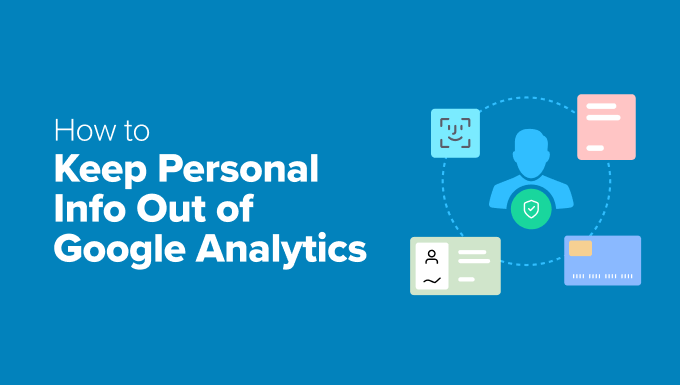
What Is Personally Identifiable Data, and Why Ought to You Defend It?
Personally Identifiable Data (PII) is any information that, when mixed, can reveal an individual’s identification.
Some widespread examples of PII embody:
- Full identify (first and final)
- Email address
- Cellphone quantity
- House tackle
- Bank card info
- Login credentials (usernames and passwords)
- IP addresses (when linked to people)
The issue is that PII typically sneaks into Google Analytics via URLs.
Let’s say that customers submit private particulars on contact forms or login pages in your WordPress web site. This information might be embedded within the URL of the subsequent web page they go to.
The URL would possibly seem like this:
www.instance.com/contact-us/thanks?e mail=private@info.com.
In that instance, we will see that the URL reveals the person’s e mail tackle.
Why Ought to You Preserve Private Information Out of Analytics?
Privacy laws like GDPR are critical about defending private information. That’s one cause why Google doesn’t enable companies to gather or retailer PII.
In case your Google Analytics account is capturing PII, you could possibly find yourself in bother, dealing with hefty fines or having your account suspended.
And it’s not only a technical challenge – it could actually have actual penalties for your online business. Customers anticipate companies to respect their privateness. But when they really feel their information isn’t protected, they could take their enterprise elsewhere.
That’s why it’s so essential to maintain PII out of your Google Analytics information.
With that in thoughts, we’ll present you find out how to maintain personally identifiable info (PII) out of Google Analytics. Right here’s a fast overview of the two strategies we’ll share with you:
Prepared? Let’s get began.
Methodology 1. Utilizing a Plugin to Preserve Personally Identifiable Information Out of Google Analytics
Google Analytics might be overwhelming to navigate, particularly when making an attempt to make sure compliance with privateness rules.
Managing cookie consent, anonymizing IP addresses, and adjusting privateness settings can shortly change into overwhelming. For many individuals, sorting via these settings and guaranteeing compliance is not any straightforward process.
If you happen to’re a WordPress person, then now we have excellent news for you.
MonsterInsights is the best WordPress analytics plugin, and it integrates seamlessly with Google Analytics 4 (GA4). With its Privateness Guard characteristic, it gives privacy-friendly monitoring that you would be able to handle straight out of your WordPress dashboard.
ℹ️ Fast be aware: MonsterInsights powers our conversion monitoring at WPBeginner, serving to us monitor visitors, kinds, buttons, referral hyperlinks, and extra with ease. See why we find it irresistible in our detailed MonsterInsights review!
Step 1. Set up and Activate the MonsterInsights Plugin
First, let’s get began by making a MonsterInsights account. Simply head over to the web site and click on the ‘Get MonsterInsights Now’ button.
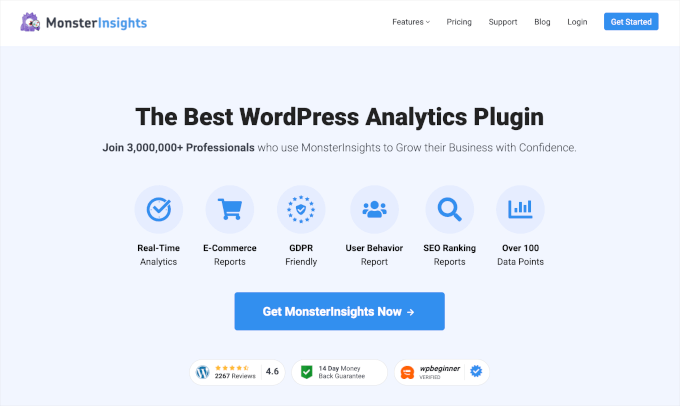
You may then go forward and select a plan. For this tutorial, we suggest the Plus plan or increased, because it contains the Privateness Guard characteristic to assist with compliance.
After signing up, you may set up and activate the MonsterInsights plugin in your WordPress web site. For step-by-step directions, see our information on how to install a WordPress plugin.
Step 2. Join MonsterInsights to Your Google Analytics Account
Upon activation, you’ll want to attach the MonsterInsights plugin to your Google Analytics account.
In your WordPress dashboard, you’ll want to go to Insights » Launch the Wizard to begin the setup.
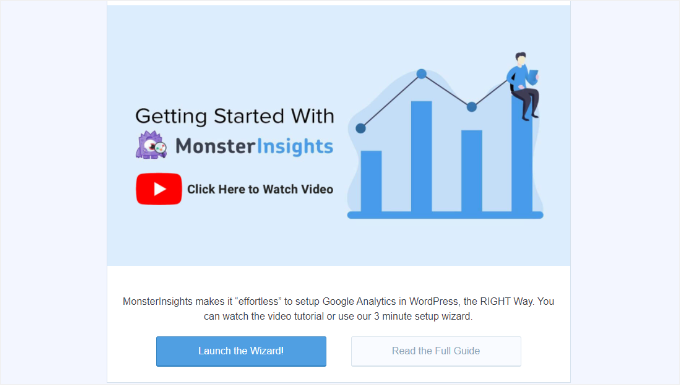
After that, you’ll choose the class that finest describes your web site.
MonsterInsights offers 3 choices – business site, writer (weblog), or eCommerce (online store).
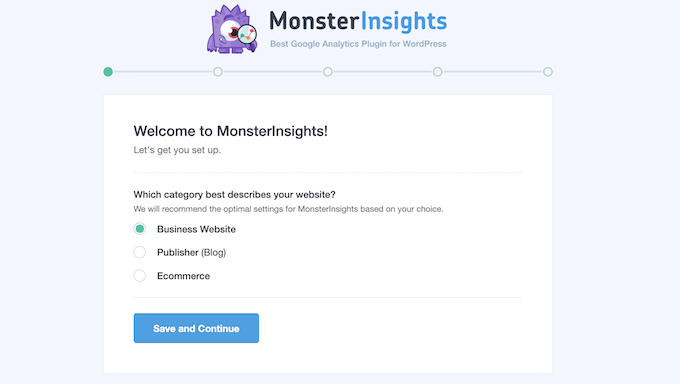
After deciding on a class, merely click on ‘Save and Proceed’ to proceed.
On the subsequent display screen, you may click on ‘Join MonsterInsights’ to begin the connection course of.
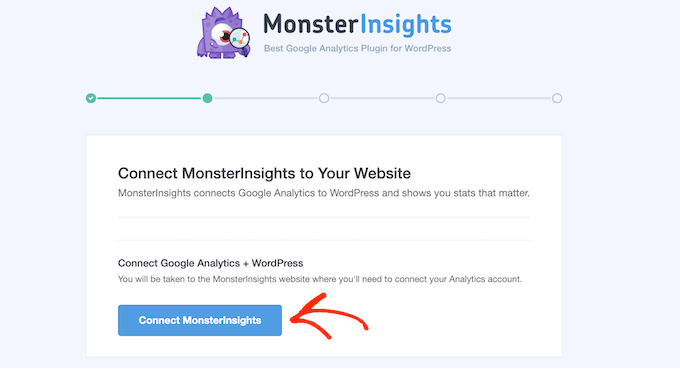
Then, you may comply with the immediate to register to your Google Analytics account.
Upon signing in, you may choose the web site you wish to monitor from the dropdown menu.

From right here, go forward and click on the ‘Full Connection’ button. MonsterInsights will then robotically set up Google Analytics in your WordPress website.
For particulars, be at liberty to confer with our information on how to install Google Analytics in WordPress.
Step 3. Allow the Privateness Guard Function
Retaining Personally Identifiable Data (PII) out of your monitoring doesn’t need to be sophisticated.
With MonsterInsights’ Privateness Guard, you are able to do it in only a few clicks!
This characteristic robotically scans your web site for delicate info. It checks for any personal particulars and prevents them from being saved in your analytics stories.
These particulars might be:
- Kind submission information, corresponding to private info entered in touch or registration forms.
- URL information, which is the total net tackle of the web page, together with the domain name, path, and any further info.
- Question parameters, that are the bits of information in URLs, like “?id=1234.” They typically monitor particular person actions or present further info to the web site.
To do that, let’s navigate to the Insights » Settings » Engagement tab.
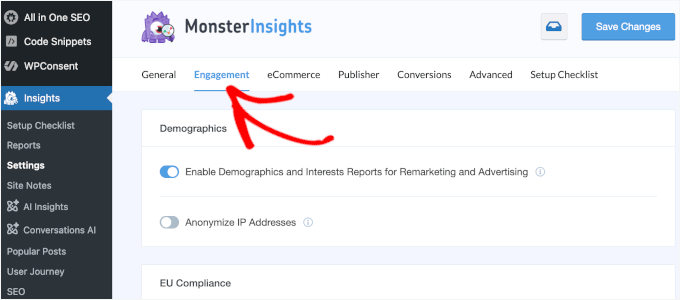
From right here, you may go forward and activate the ‘Privateness Guard’ swap – that’s it!
MonsterInsights will now assist defend personally identifiable info and maintain you compliant with privateness legal guidelines.
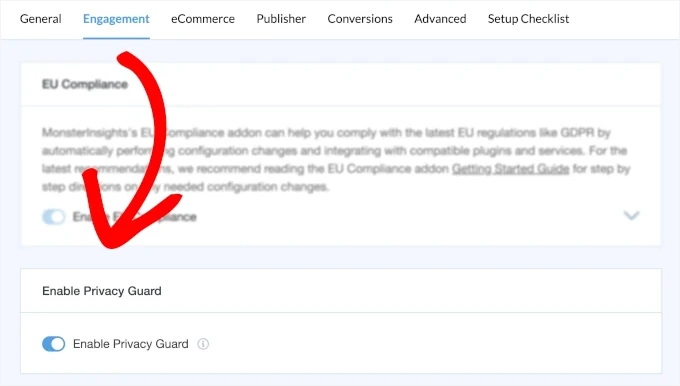
⚠️ Necessary Disclaimer: No plugin can assure 100% authorized compliance as a result of each web site is totally different. We strongly suggest consulting an Web regulation lawyer to make sure your web site meets all authorized necessities on your location and particular use case.
This isn’t authorized recommendation – only a pleasant heads-up that will help you keep knowledgeable!
Methodology 2. Retaining Personally Identifiable Information Out of Google Analytics
On this technique, we’ll information you thru configuring the settings that you’ll want to maintain PII out of Google Analytics straight from its dashboard.
This selection is finest for superior customers, because it offers you full management over the setup.
Moreover, since this technique isn’t restricted to WordPress, you may comply with alongside even when you made your web site with a distinct website builder.
First, you’ll have to register to your Google Analytics account.
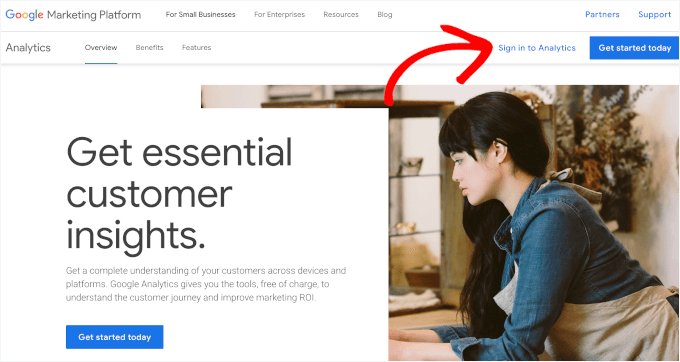
Go forward and click on on the ‘Sign up to Analytics’ button.
Within the dashboard, let’s hover over the sidebar and click on the ‘Admin’ menu.
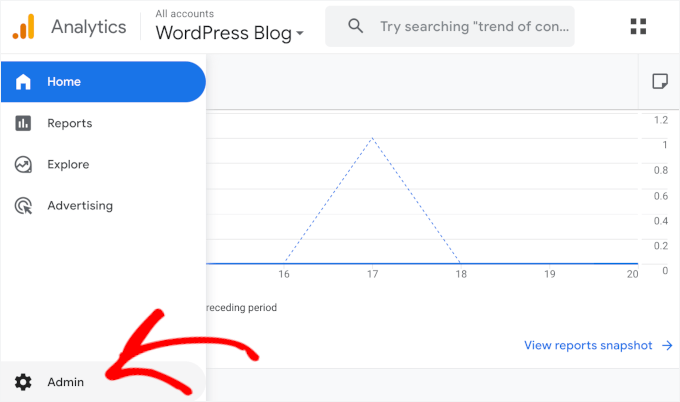
As soon as inside, you’ll wish to find the ‘Information assortment and modification’ part.
After that, let’s click on on ‘Information streams.’
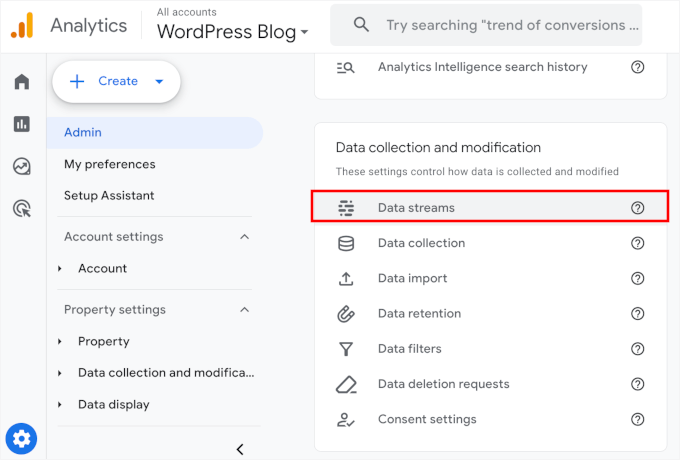
This can take you to the desk, which lists all of your information streams.
Now, you may choose your web site from the record.

This can open the ‘Net stream particulars’ slide-in.
From right here, let’s scroll right down to the ‘Occasions’ part and click on ‘Redact information.’
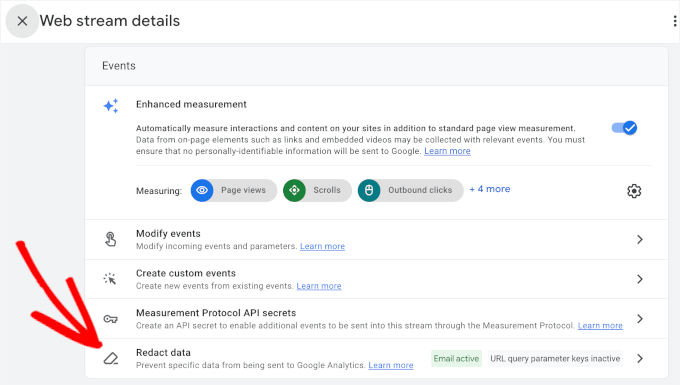
On the subsequent display screen, you will note the ‘Redact information’ menu.
The ‘Select what to redact’ part of this slide-in has two switches on the prime.
Let’s first redact e mail addresses by flipping the swap. Google Analytics will then robotically exclude e mail addresses from the info it collects.
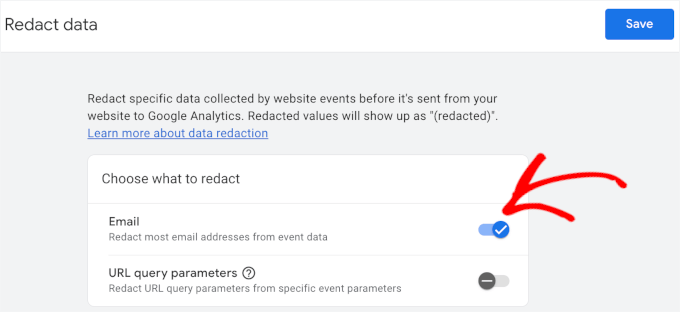
Then, you may filter out different PII by getting into question parameters.
To do that, you’ll have to allow the swap for ‘URL question parameter.’ Then, you may enter your question parameters within the respective discipline.
For instance, right here, we added ‘identify,’ first_name,’ ‘last_name,’ and ‘ip_address.’

As soon as every thing seems to be good, it can save you your settings.
Google Analytics will now assist defend PII and maintain your web site privacy-compliant.
⚠️ Necessary Disclaimer: Configuring settings manually within the GA4 dashboard requires exact data of which information must be redacted.
This may be tough, and even a small mistake could lead to delicate info being collected.
We suggest completely reviewing your information assortment settings to make sure all PII is correctly excluded. At all times take the required precautions, as improper configuration might result in compliance points.
Bonus Suggestions for Privateness Compliance on Your Web site
Retaining private information out of analytics stories is only one option to adjust to privateness rules. We additionally suggest following the following tips:
For extra particulars, simply see our complete guide to GDPR compliance for WordPress customers.
FAQs About Retaining Personally Identifiable Information Out of Google Analytics
Retaining PII out of Google Analytics is essential for privateness and compliance. If you happen to nonetheless have questions, be at liberty to try some fast solutions to widespread questions:
How does Google deal with person information and privateness considerations?
Google takes privateness severely. It anonymizes information and complies with strict rules like GDPR.
Whereas Google offers instruments to assist companies defend person privateness, it’s in the end as much as the companies to ensure they don’t acquire personally identifiable info (PII).
Does Google Analytics acquire personally identifiable info?
Not by default. However when you’re not cautious, PII can sneak in via URLs, kind submissions, or customized monitoring settings. That’s why it’s essential to set issues up accurately.
Do all websites with analytics want cookie warnings?
Yep! In case your web site tracks customers with cookies (like Google Analytics does), then privateness legal guidelines like GDPR and CCPA require you to show a cookie notice and get person consent.
Additional Studying: Extra Analytics and Monitoring Guides
Understanding find out how to maintain PII out of Google Analytics is only the start! If you wish to fine-tune your monitoring, enhance information accuracy, and keep compliant with privateness legal guidelines, then take a look at these useful guides:
📊 Google Analytics 4: A Beginner’s Guide – Learn to arrange GA4 in your WordPress web site and take advantage of its highly effective options.
That’s all there may be to it! We hope this information has helped you discover ways to maintain private information out of Google Analytics. You might also prefer to see our information on how to get a custom email alert in Google Analytics or our professional decide of the best WordPress GDPR plugins.
If you happen to appreciated this text, then please subscribe to our YouTube Channel for WordPress video tutorials. You too can discover us on Twitter and Facebook.




